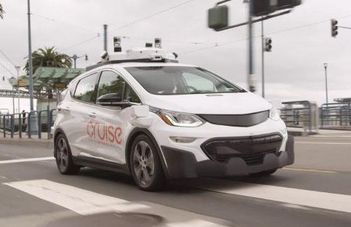
By Andrew Boada, Editor at Large
Sometimes, we get overcome with excitement when it appears that the high-tech future we have been dreaming of has finally arrived. It looks like 2019 is going to be one of those times, for that is when, after years of breathless anticipation, one OEM – in this case, GM – says its fully autonomous, self-driving car, will finally, actually and, by many accounts, well ahead of schedule, will be here.
But I have one balloon-popping, rain-on- the- parade question to pose: Will you – Mr. or Ms. fleet manager – be ponying up to buy an autonomous vehicle (AV) next year? I think not. In fact, I think no fleet manager will be seriously considering making a self-driving vehicle their go-to acquisition for many years to come.
GM isn’t alone in trying to rush us headlong into the driverless future. Honda, Hyundai and Toyota say their driverless cars will be on the road in 2020, just one year after GM’s. Daimler execs have said full-scale commercial production of its AVs may begin as soon as 2020 as well, and Volvo says theirs will appear in 2021
So why don’t I think fleets will be early adopters of AVs? I’ve got five reasons.
1. OEMs won’t be marketing to fleets. You won’t hear OEMs saying that fleets aren’t their target market when their AVs make their debut, but you can tell they won’t be because of what OEMs and industry observers do say. Which is that carmakers will be targeting ride-hailing companies, like Uber and Lyft or, in GM’s case, their own ride-hailing venture. Think of these as pilot programs where OEMs prove their concept while working out the bugs. The first fully self-driving cars may come first to retirement homes, corporate campuses and private communities: controlled environments where computers can easily map their world.
2. The AV laws of the road won’t be settled for years. Federal, state and municipal regulations governing AVs are a spotty patchwork quilt, and it’s likely to take years for sufficient uniformity to be worked out by the thousands of jurisdictions to make wide-ranging AV operation practical.
3. The technology still isn’t sufficiently advanced. Despite marketing-speak to the contrary, we’re still a long way from fully ”self-driving” cars. Driver-assist technologies capable of steering, braking and following traffic rules (with human oversight) are now entering the market, led by Tesla. Yet “it’s important to note that none of these vehicles is capable of driving safely on its own,” says David Zuby, IIHS chief research officer. “A production autonomous vehicle that can go anywhere, anytime isn’t available at your local car dealer and won’t be for quite some time.”
Among the challenges AV technology still hasn’t mastered: driving in snow and rain, determining where traffic lanes are when markings are worn away, anticipating what pedestrians and human drivers are about to do, and mistaking things like bushes and land-dividing poles for objects in their path. AV programs are cautious in these circumstances, and their hesitation could actually expose self-driving vehicles to greater risk to behind hit from behind.
4. They’re going to be intolerably expensive. OEMs have yet to set prices, but analysts say autonomous technology will add $5,000 to $15,000 to the price of a vehicle, at least before AV production is large enough to achieve economies of scale. You can add to that expense the fact that it will also cost much more to repair them if and when they’re involved in a collision, and accident risk may still be high when most other vehicles are driven by humans.
5. The American public doesn’t trust them. This final hurdle for OEMs and fleets to clear before AVs are fleet-ready may be the most challenging. After several nationally publicized fatal accidents involving advanced driver-assist vehicles, a survey conducted last spring by AAA found that nearly three-quarters of all Americans are fearful of riding in a self-driving car, up from 63 percent in late 2017. This means that consumer demand sufficient to achieve lower AV prices is a long way off. Meanwhile, fleets are unlikely to foist AVs on a wary driver base, much less get by their lawyers’ cautious eyes.
OEMs are in a race and so are eager to be optimistic and promote their progress in developing self-driving vehicles. There are several incentives to engage in hype: image-polishing, earning media attention, boosting engineer recruiting efforts, and attracting investors. But fleet managers need to separate the hype from the reality. Fortunately, they’re unlikely even to be asked to buy an AV for quite a while, so it’s going to be relatively easy for them to adopt a prudent “wait and see” attitude. It says here it will be at least one full cycle of complete fleet vehicle turnover, if not more, before fleet managers will be ready to buy.



